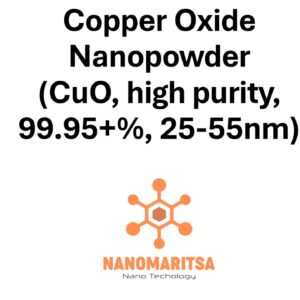Tin Oxide Nanopowder (SnO2, High purity, 99.7%, 35-55nm)
€80.00
CompareTin oxide nanopowder (SnO2, high purity, 99.7%, 35-55 nm) is a highly pure material with distinct electrical, optical, and catalytic properties that make it ideal for use in a variety of industrial, environmental, and technological applications. Tin oxide, or stannum oxide, is a versatile material with a wide range of uses in sensors, electronics, energy storage, and environmental technologies.
Composition and Structure
SnO2 (Tin Oxide):
Tin oxide is an inorganic compound consisting of tin and oxygen. It is a transparent conducting oxide with a tetragonal rutile crystal structure, which contributes to its unique properties. SnO2 is well-known for its stability and conductivity, making it a valuable material in several high-performance applications.
Purity (99.7%):
This nanopowder has a purity of 99.7%, meaning it contains only trace amounts of impurities, ensuring high consistency and reliability in applications that require precise material properties.
Particle Size (35-55 nm):
With a particle size range of 35-55 nm, this tin oxide nanopowder exhibits a large surface area and excellent reactivity, enabling its effective use in applications that demand high surface interactions and performance at the nanoscale.
Properties
- Electrical Conductivity:
Tin oxide is a semiconductor with good electrical conductivity. Its conductivity can be enhanced by doping with other elements, making it useful in electronic devices like transparent conductive films and sensors. - Transparency and Optical Properties:
Tin oxide has optical transparency in the visible range, which, combined with its conductivity, makes it an ideal material for applications in optoelectronics such as touchscreens, displays, and solar cells. - Catalytic Activity:
The high surface area and reactivity of tin oxide nanoparticles make them effective as catalysts in chemical reactions. SnO2 is commonly used in gas sensors and catalytic converters, where it can interact with gases to trigger chemical transformations. - Chemical Stability:
Tin oxide is chemically stable and resistant to corrosion, ensuring that it maintains its properties over time in harsh environments, such as high humidity or exposure to reactive gases. - Surface Reactivity:
Due to the fine particle size of 35-55 nm, SnO2 nanoparticles exhibit enhanced surface reactivity, which is crucial for applications in catalysis and sensor technologies. The increased surface area allows for better interactions with surrounding materials, improving performance in these applications.
Applications
1. Sensors and Gas Detection:
Gas Sensors:
One of the most common uses of tin oxide nanopowder is in gas sensors, especially for detecting gases like carbon monoxide, nitrogen oxides, and volatile organic compounds (VOCs). SnO2 sensors operate on the principle of conductivity change upon exposure to target gases, with the fine particles providing a high surface area for enhanced sensitivity.
Environmental Monitoring:
Due to its ability to detect pollutants at low concentrations, tin oxide nanopowder is used in environmental monitoring devices, helping to detect hazardous gases in industrial, urban, and indoor environments.
2. Electronics and Optoelectronics:
Transparent Conductive Films:
Tin oxide is widely used in the production of transparent conductive films, which are applied in devices such as touchscreens, solar cells, and flat-panel displays. The nanopowder’s combination of electrical conductivity and optical transparency is essential for these applications, where transparency is crucial without sacrificing electrical performance.
Electrodes in Solar Cells:
In solar cell technology, tin oxide nanopowder is used as a transparent electrode material, contributing to the efficiency of photovoltaic cells. Its conductivity and transparency allow it to effectively collect and transport electrical charge while allowing light to pass through to the active layer.
3. Catalysis and Environmental Protection:
Catalytic Converters:
Tin oxide is used as a catalyst in automotive catalytic converters, where it helps to reduce harmful emissions by converting pollutants like carbon monoxide, hydrocarbons, and nitrogen oxides into less harmful substances.
Water Treatment and Air Purification:
Tin oxide nanoparticles have been explored in the field of water and air purification, where their catalytic properties help degrade pollutants or convert harmful gases into safer substances. In photocatalytic applications, SnO2 can also degrade organic contaminants when exposed to light.
4. Energy Storage and Batteries:
Lithium-ion Batteries:
Tin oxide is used in lithium-ion batteries as an anode material, offering higher capacity and better cycling stability compared to traditional graphite anodes. The nanopowder’s high surface area and electrical conductivity contribute to improved battery performance.
Supercapacitors:
Tin oxide nanoparticles are also employed in supercapacitors, where their high conductivity and surface reactivity allow for efficient charge storage and discharge. This makes them ideal for energy storage applications requiring rapid charge and discharge cycles.
5. Coatings and Surface Treatments:
Conductive Coatings:
Tin oxide nanopowder is used in the formulation of conductive coatings for various surfaces, including glass, metal, and ceramics. These coatings are employed in applications such as anti-static surfaces, electromagnetic shielding, and energy-efficient windows.
Corrosion Resistance:
The chemical stability of SnO2 also makes it suitable for protective coatings that resist corrosion in aggressive environments, such as marine applications or chemical processing industries.
Safety and Handling
Health Considerations:
Tin oxide nanoparticles are considered to be relatively safe when handled properly. However, as with all nanopowders, precautions should be taken to avoid inhalation or skin contact. Proper protective equipment such as gloves, masks, and goggles should be worn during handling.
Environmental Impact:
Tin oxide is generally regarded as environmentally friendly, but the long-term effects of nanopowders in the environment are still under study. Appropriate disposal methods should be followed to prevent environmental contamination.
Summary
Tin oxide nanopowder (SnO2, high purity, 99.7%, 35-55 nm) is a highly versatile and effective material with applications across multiple fields, including sensors, energy storage, catalysis, and optoelectronics. Its unique combination of electrical conductivity, optical transparency, chemical stability, and catalytic properties makes it a key material in the development of advanced technologies for environmental protection, electronics, and energy solutions.
| Measurement (gr) | 100 grams, 500 grams, 1000 grams |
|---|






